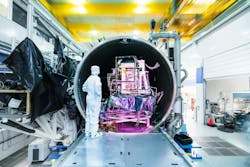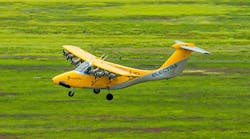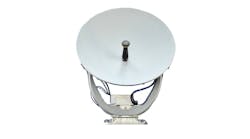EL SEGUNDO, Calif., - Raytheon in El Segundo, Calif. announced its latest Visible Infrared Imaging Radiometer Suite (VIIRS) sensor has completed a test milestone. The VIIRS instrument observes and collects global environmental data that spans visible and infrared wavelengths across land, ocean, and atmosphere and is a part of the National Aeronautics and Space Administration and National Oceanic and Atmospheric Administration's (NASA-NOAA) Joint Polar Satellite System (JPSS) series of satellites.
Data and imagery obtained from satellites in the JPSS constellation will increase the timeliness and accuracy of public warnings and forecasts of climate and weather events, thus reducing the potential loss of human life and property. As a result, information from JPSS supports every area of NOAA's mission, including supporting a more "Weather-Ready Nation," healthy coasts, resilient coastal communities, and adapting and mitigating climate change.
Polar-orbiting satellite data is the most important type of observation for accurately predicting weather three to seven days in the future. The primary user of JPSS data is NWS. Once the polar-orbiting data is retrieved from the JPSS satellites, the data is entered into NWP models that are utilized by NOAA's NWS to predict medium- and long-term weather, including severe weather phenomena.
Related: NASA announces winners of the wildfire climate tech challenge
The last of the four JPSS VIIRS Sensors, called J4, is in environmental testing and successfully completed Thermal Vacuum tests in late 2023. This milestone was completed ahead of schedule, ensuring the VIIRS program is on track to deliver the final sensor on time for satellite integration in 2024.
"The recent thermal vacuum testing on J4 was the most successful and efficient cycle in the program's history, demonstrating the team's experience and the collaboration between NASA and Raytheon that allowed for seamless test execution," said Sandy Brown, president, Space Systems for Raytheon.
NASA's Joint Polar Satellite System is the U.S. contribution to the next-generation polar-orbiting operational environmental satellite system. VIIRS is one of the instruments on JPSS that consists of 22 bands that provide high radiometric accuracy and spatial resolution multispectral imagery, including the unique panchromatic Day/Night band (DNB), that provides visible and infrared imagery used for fire and air quality monitoring, agriculture monitoring, carbon modeling, flood and sea ice mapping, and other fundamental data products used by the science community. Raytheon has designed, built and delivered four VIIRS instruments since 2010.



